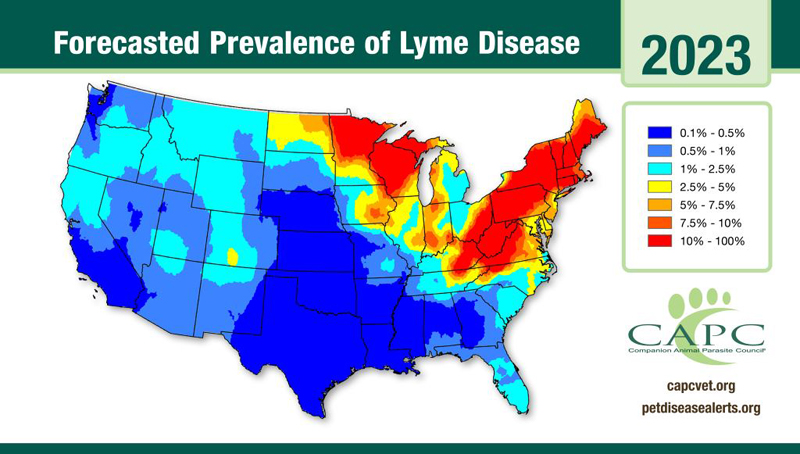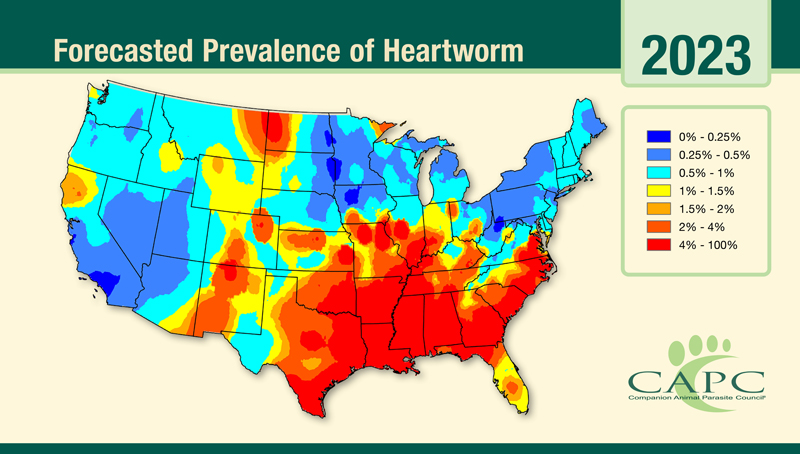 Lyme disease is expected to pose higher-than-average risk this year, the Companion Animal Parasite Council (CAPC) reports.
Lyme disease is expected to pose higher-than-average risk this year, the Companion Animal Parasite Council (CAPC) reports.
The group has released its 2023 Pet Parasite Forecast and corresponding 30-day Pet Parasite Forecast maps, alerting veterinarians and pet owners of impending outbreaks across the U.S. and Canada.
CAPC predicts instances of Lyme, transmitted by the black-legged (deer) tick vector (Ixodes scapularis), will be higher than average throughout 2023, with continued expansion southward and westward outside of the historically high-risk areas in the Northeast and Upper Midwest, including Wisconsin, Minnesota, and the upper peninsula of Michigan. A higher-than-normal risk is also expected in North Dakota, northeastern South Dakota, Iowa, Illinois, and eastern Kentucky.
Further, CAPC reports a northern expansion into Canada, including southern regions of Ontario, Quebec, and Manitoba, as well as on New Brunswick and Nova Scotia, due to increased Lyme detection in Canadian dogs. Pets living in or traveling to these areas are considered at high risk.
“Because of the zoonotic potential of pathogens like Lyme disease, we started providing annual forecasts 11 years ago to alert communities about the risks they pose to people and pets,” says CAPC’s CEO, Christopher Carpenter, DVM. “Lyme disease, in particular, is an important One Health pathogen that occurs in both veterinary and human medical settings.”
The increase in Lyme prevalence can be attributed to land use, human population growth, urbanization, and changes in wildlife host density and location, the council reports. Risk has also increased due to rehoming of pets, as well as changes in:
- Distribution and prevalence of vector (tick) populations
- Shifting wildlife populations and their infiltration into newly developed and reclaimed areas
- Short- and long-term changes in climatic conditions
- Changes in habitat due to natural or human-induced processes
In addition to Lyme, CAPC’s 2023 Pet Parasite Forecast shows a continued geographic prevalence of heartworm, transmitted by mosquitos, along the Mississippi River, throughout the southern portions of the interior Midwest, and along the Atlantic coast north into Virginia and southern New Jersey.
Veterinarians in states with historically lower prevalence are cautioned about the increasing risk of heartworm infection and are encouraged to discuss this changing prevalence with their clients, CAPC reports, adding that this is particularly important in Indiana, central and northern Illinois, southern Iowa, Kansas, and, in the Great Lakes region, Lower Michigan and Ohio.
“CAPC’s Pet Parasite Forecast is critical to alerting pet owners, veterinarians, and physicians to the risks this year and reinforcing CAPC’s recommendation that all pets need to be annually tested and protected year-round,” Dr. Carpenter says.
For more, click here.


